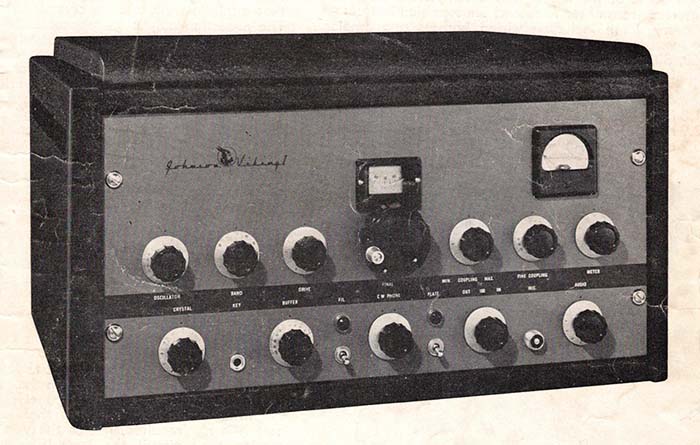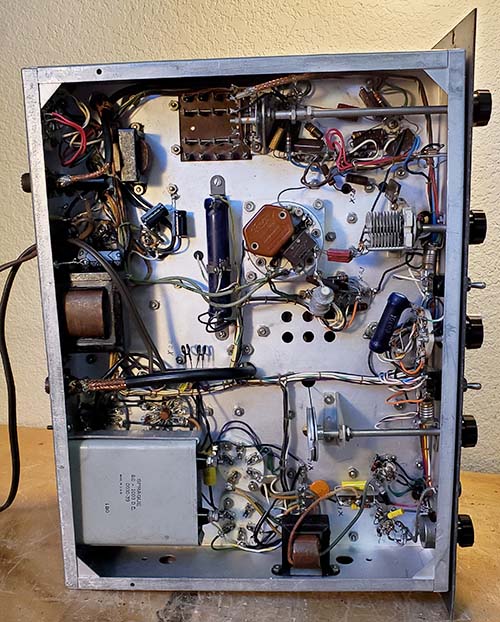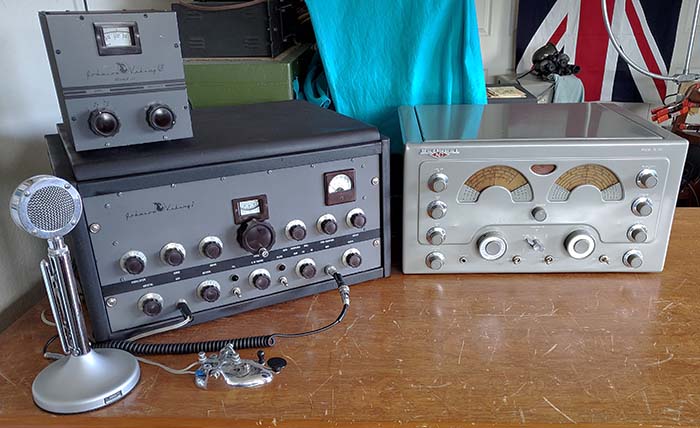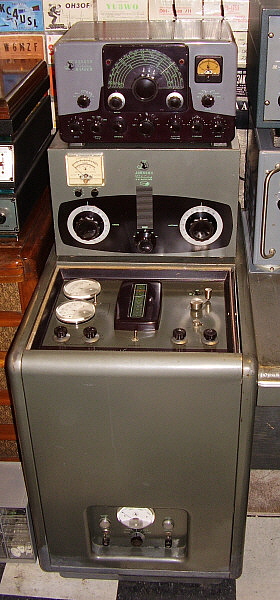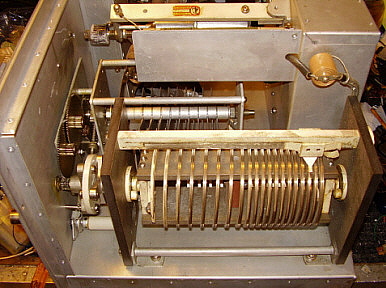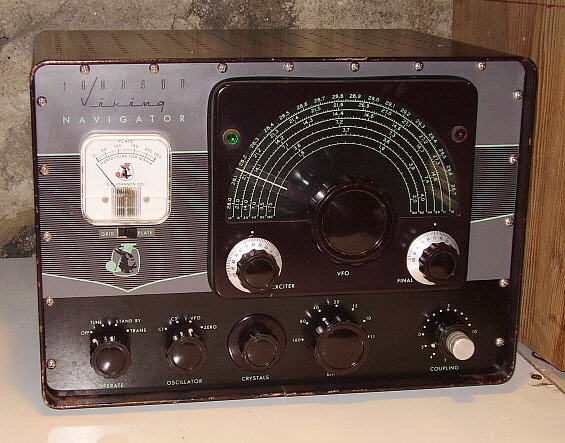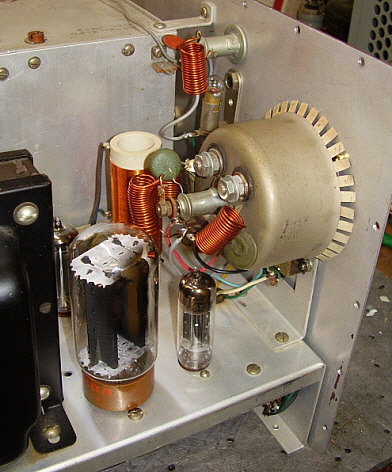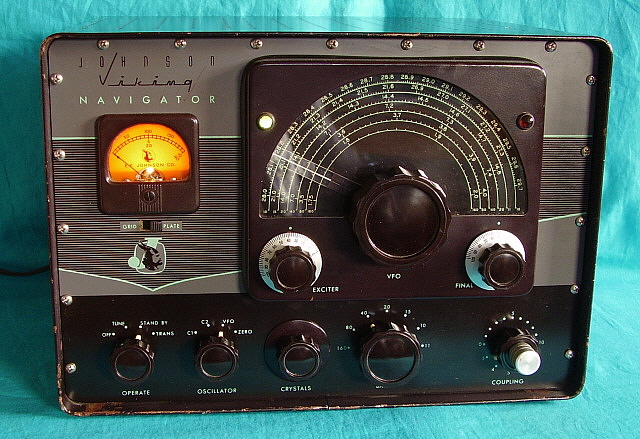|
Johnson-Viking Ranger
The Viking Ranger was a 75 watt CW or 65 watt AM
exciter-transmitter that covered 160M to 10M and had a built-in VFO that
was very stable. The audio section featured a special modulation
transformer with a winding that was used for negative feedback resulting
in excellent quality audio. The PA tube is a single 6146 and the
modulator tubes are a pair of 1614 tubes. The Ranger had all of the
outputs accessible to interface with the Desk KW for sufficient drive
for full output from the Desk KW. Generally a small attenuator is
inserted between the Ranger RF output and the Desk KW input to allow
better adjustment of the Ranger's drive and output circuits. Rangers were very popular as a
stand-alone transmitter also, especially for Novices since the power
limit then was 75W on CW only, crystal control (you got to use the VFO
after you up-graded your license.) Still today, the Ranger is a popular
transmitter for vintage AM because of its excellent audio and
"bullet-proof" construction. Over 14,000 Rangers were built. They were
available as either a kit or fully assembled. Prices were $293 assembled
or $214.50 as a kit. The later version was designated as the Ranger II
and featured different modulator tubes, a two-tone gray paint job and
dropping the 11M coverage in favor of 6M coverage.
The very first transmitter I owned was a $75 Viking Ranger. I
bought it when I got my Novice license in March 1970. At the time,
Novices were limited to 75 watts input power, Crystal Control and CW only on 80M,
40M and 15M. Voice was allowed on 2M. I used the Ranger for six months,
the length of time I had my Novice license until I upgraded to General
Class. I traded the Ranger in on a Hallicrafters HT-37 that was very
oxidized on the chassis and probably didn't work all that well. By
December 1970, I had purchased a used Collins KWS-1 transmitter (that I
still have.)
The Ranger shown belongs to Sharon KK7EI. When she
became a Novice in 1975, I bought the Ranger for her from Bob Meckley (I
don't remember his callsign,) who was
the photographer at Bentley Nevada Corporation (where I worked then.) I paid
Bob $50 for the Ranger and it was operational and in good physical
condition. Sharon's call was WN7AZE. Novice Class at that time was
still 75 watts maximum power input but the license was good for two years (non-renewable) and you could use a VFO, CW only on 80M, 40M and 15M.
Sharon let that license lapse but got another Novice when we had the
radio museum (in the 1990s.) She did the 13WPM CW test at the Novice exam (just to
show-off, I guess) and then upgraded a month later to General doing the
written exam then. She
upgraded to Advanced with that written test a month later. The call KK7EI was the
FCC-issued call she was given at that time and which she still holds. >>>
|
>>> The Ranger was a factory assembled one. You can tell
because the tube sockets are riveted to the chassis while the kit
versions will have tube sockets that are mounted with screws and nuts.
The Ranger worked very well except for an intermittent problem. The
trouble was with the 6AX5GT rectifier tube socket. It seemed someone had
glued the loose base on the 6AX5GT tube and that glue had run down into
the socket. I cleaned the socket several times but
it was always getting glue that was somehow caught inside the socket
somewhere to cause intermittent problems. I finally had to replace the socket
which was unfortunate since now that tube socket is mounted with screws
and nuts instead of rivets.
Of course, I had replaced the glued 6AX5GT long before. Other upgrades
were replacing the capacitors, not with different values, just new
capacitors. The regulator load resistor was changed to a 10 watt
resistor but remained located in the VFO compartment. A photo of the
Ranger is in the Desk KW section.
I used the Ranger for several years as the exciter for
the Johnson Desk KW. That combo was on the Saturday morning 3870 AM net
running 275 watts in the "Tune Mode." The Ranger's excellent audio is a
result of its special modulation transformer that has a specific winding
for negative feedback. I didn't have an attenuator between the Ranger's
50 watt RF output and the Johnson Desk KW that only requires about 30
watts of drive. Instead, I reduced the drive level on the Ranger until I
had about 12mA of grid current for the Desk KW amplifier tubes. This
really isn't the best way to drive the Desk KW. A 3db attenuator between
the Ranger and the Desk KW would allow the Ranger to operate closer to
specifications.
With the closing of the Western Historic Radio Museum in
2012
and the subsequent move to Dayton, Nevada, I disassembled the station in
Virginia City. Since the move, the Ranger was used one time and that was with a different
Viking Desk KW to help out Ham and Hi Fi, who was trying to get a Desk
KW ready to sell. The Desk KW had belonged to NU6AM who had used it for
years. It was functioning fine until it was disassembled to allow it to
be moved from Los Altos, CA up to Sparks, NV. H&HF reassembled the
Desk KW but didn't have any way to drive it. I brought over my Ranger
and the interconnecting cables to drive their Desk KW into their dummy
load. Although it would power up the filaments any attempt at "Tune
Mode" transmit (+1250vdc plate voltage) would blow fuses. In the last
attempt more than just the fuse blew,...my Ranger's function switch
arced-over. I suspect there was a "compatibility problem" with the H&HF
Desk KW having something different in the wiring of the interface cable.
I didn't really have the time or even the opportunity to investigate
that possibility. I know my Ranger and cable (and my Desk KW) were wired
exactly per the manual but I don't know about the H&HF desk (and they
didn't get the NU6AM Ranger or the interconnect cable in their purchase,
just the Desk KW.) H&HF gave me a "junker" Ranger chassis that was stripped but still
had the Function switch, so I could repair my Ranger, which I did. I've used it a couple of times since then, whenever I needed
about a 50 watt RF source for testing, but it hasn't really been "on the air"
since 2012. |
